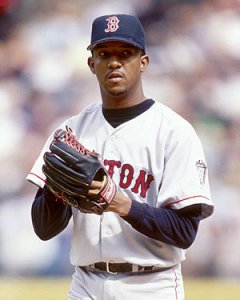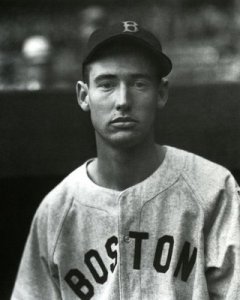Passionate Red Sox fans are still trying to wash the bitter taste of defeat from their mouth after watching the Red Sox hand a sure victory over the New York Yankees last October. Once again, we had to endure the taunts from the Yankee faithful and talk of an unspoken curse made by a dead ballplayer. Then, we watched these two teams play hardball in the baseball market; the Sox lured Curt Schilling away from balmy Arizona and the Yankees while New York snatched Alex Rodriguez, a player that was thisclose to being in a Red Sox uniform. In March, spring training tickets between the Sox and Yanks were fetching $500 each for a game that no impact on the upcoming season except to evaluate non-roster invitees vying for a spot on the parent club. As the season began, the rivalry was about as heated as it has ever been and we wondered what stories would be written this year.
So Sunday afternoon, as I watched Gary Sheffield weakly swing at strike three from Scott Williamson to end a three-game sweep at Yankee Stadium, I had to stop myself from clapping and cheering too loudly in my living room, less I wake up my sleeping son on the other end of the house. Boston has just managed to take six out of a possible seven games in ten days from New York and, while fans of Boston were trying their best to stay grounded and remind themselves that championships are won in October, Yankee fans were jeering their beloved nine. Peering into the enemy dugout, the pinstriped hosts looked as if they had just been to a funeral. Meanwhile, the visitors casually filed onto the field to congratulate each other and fans wondered if they were not feeling as elated as the rest of New England.
Something just did not feel right, though. Granted, as it has already been established, it’s only April and the Sox have plenty of games left to play before the season ends. However, that was not what bothered me. Had the Yankees, with eight All-Stars in the starting lineup for Sunday, been unable to beat a Red Sox team that was missing Nomar Garciaparra and Trot Nixon? Were they not able to get into the mind of Pedro Martinez, who had single-handedly (with some help from Grady Little) given Game Seven of last year’s American League Championship series back to the Yankees? What happens when our team is finally together as it was put together on paper in the off-season; what will happen then when these two collide later this season?
No one should feel sorry for the New York Yankees with the 26 world championships and the $183 million payroll. No sympathy cards must be mailed to George Steinbrenner. No flowers need to be delivered to Joe Torre or Brian Cashman’s office. No Get Well cards must be sent to Derek Jeter or Alex Rodriguez. If the Yankees have proven one thing over the years, it is their resilient nature and the ability to bounce back from troubled times. No one truly believes that the Yankees are done; it’s only April, remember?
Yet, what if this is the season that the Yankees finally come apart at the seams? What if they are doomed to a .500 season, or worse? What if the team doesn’t improve much from its abysmal .217 batting average, 53 points less than opponents are batting against them? Have teams from the AL East finally figured out how to pitch around these guys? Have they lost the ability to produce runs when needed, one at a time? Will the jeers from the minions at Yankee Stadium continue into May, then June, and perhaps all the way into September?
As a Red Sox fan, my first priority is to see that the Red Sox win the World Series. My only contribution to this effort is my unyielding support through thick and thin and perhaps the purchase of some tickets every season. However, what I would love nothing more is to see that, on the way, they stomp on New York to earn that title. I don’t mean win 15-of-19 games during the regular season and finish 20 games in front of them; I want another classic ALCS showdown.
I want to see a series between them that ends with the Red Sox streaming onto the field, jumping on each other’s backs, spraying champagne on reporters, and blowing smoke from nice juicy cigars. I want to see the ghost of Ted Williams in a corner of the clubhouse standing there with a knowing smirk. I want to see Johnny Pesky cry tears of joy. I want to see a dejected Yankee squad slowly file back to the clubhouse, hanging their heads, and wiping a few tears from their eyes.
Truthfully, at this point, I and the rest of the Boston faithful just want to see the Red Sox win their first championship in 86 years, and it doesn’t matter to me what teams they must push aside to get there. What would give me the most satisfaction, however, is to know that we went through New York to do it. Having been in their shadows for so long – 86 years, to be exact – nothing would be sweeter than to finish what was started in 2003, when the Red Sox came so very close to making this wish come true.

